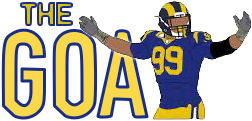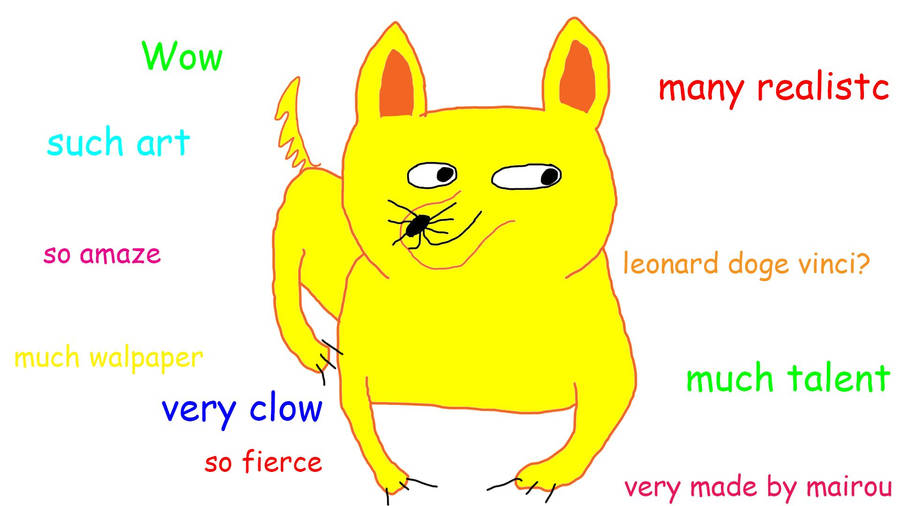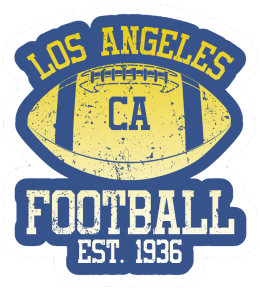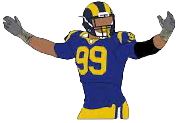- Joined
- Nov 17, 2014
- Messages
- 6,241
Imma gonna leave this here. To be honest I think the chance of him being a good starter again are as decent as Foles becoming a good starter again.
https://www.washingtonpost.com/news...cant-assess-the-rest-of-the-redskins-offense/
Former Redskins tight end Chris Cooley has spent the past couple of seasons doing weekly film breakdowns of every Redskins starter on his ESPN 980 afternoon program. Whether or not you trust Cooley’s analysis, he offers a detailed level of praise and criticism that isn’t always easy to find, filled with specifics and a sometimes startling frankness.
This week, during his weekly look at the team’s offense, Cooley changed things up. He spent an entire half-hour dissecting the play of just one man: the quarterback, Robert Griffin III.
“What we are going to do is we are going to give incomplete to the entire offense,” Cooley said. “Because I don’t know how to grade them….I can’t grade the pass game. Our quarterback does not allow a proper grading of the pass game, because there was something I’ve never seen go on on a football field before.
“There was a game plan initially installed, which was not run or operated in any way shape or form the way it should have been,” Cooley went on. “There was a quarterback not reading the field when he should have been, there was a quarterback scrambling when he [shouldn’t have been]….You can’t grade anyone else around Robert because of the way Robert played.
“And I want this to be really clear as we move forward with this breakdown,” Cooley said. “I’m not making fun of Robert. I like Robert. I like him as a person. This is not a personal attack. I am not going to make fun of him. I think he handled the media afterward improperly; we’ve discussed that. And I think he played poorly. And because of that, I’m going to now walk you through the game.”
What followed was 24 minutes of detailed criticism of Griffin’s performance, and it was ugly, far uglier than any analysis of Griffin’s leadership or social-media missteps or news conference hiccups. Cooley said Griffin often looked to the wrong part of the field. He said Griffin repeatedly failed on basic fundamentals. He said Griffin missed what should have been easy reads, didn’t see open receivers, didn’t interpret defensive formations correctly, didn’t understand basic game-management principles, could not allow his team to run any semblance of its offense.
Griffin on the move
“He can’t move left, he can’t slide [his feet], he always turns to run,” Cooley said. “When he’s moving in the pocket, it’s always a running gesture, it’s always a tuck-ball-and-run gesture. It’s not keep poised, keep shoulder back, keep ball pressed back ready to throw, shuffle and slide. It’s a tuck-ball-run, then look to throw. This takes all vision off the field for Robert. When he takes all vision off the field at this point, he loses where he wants to go with the football. Which means unless someone’s coming across the field, directly into his vision, he is not able to find them or throw to them.”
Griffin’s second interception

(Fox)
“They come and show blitz,” Cooley said. “We have four slants: two inside slants and two outside slants. (The receivers are circled in red) The inside slants are pretty much dead [on arrival]. Their job is just to run through the inside defender’s shoulder, to create space for the outside slants. There’s one linebacker dropping, the guy that [eventually] taps the ball (the purple circle). As he drops, he drops directly to Robert’s left, which is where Robert throws the football.
“So if you’re looking at the line of scrimmage and you see one guy start to bail [to the left], work the right side of the field. See that coverage. Don’t just say ‘I have slants and I’m gonna throw slants.’ See where your backer’s dropping and work slants to the other side, because if you do complete the ball [to the right side], it’s a big play, if you work it away from where the backer’s dropping”

(Fox)

(Fox)

(Fox)
You can see the backer drop, watch Griffin’s eyes, move to Griffin’s left, and then tip the ball, leading to the game-changing interception.
The sacks
“He’s setting at nine yards, and he’s sitting,” Cooley explained. “He takes a four-step drop, he doesn’t make a throw, he’s unwilling. At nine yards, you’re a sitting duck. You have got to step up and slide, move in the pocket. You can’t remain at nine yards. Offensive linemen don’t block defensive linemen with their quarterback at nine yards. They block expecting their quarterback to step up at six yards.
“These guys are going to really struggle with the idea of how are we going to block for this guy? I don’t know how to block for this guy. He’s going to make us look bad. Because he’s setting up at nine yards, and I’m giving up a sack, but my entire career has been based on the idea that an edge set at nine yards is good enough for a quarterback to step up and throw the ball. He will not.”
Here you can see that Griffin sets up exactly nine yards behind the line of scrimmage. Then he is swallowed whole by the defensive line, still exactly nine yards behind the line of scrimmage.

(Fox)

(Fox)
The first red zone sack
The most disheartening sequence of the game came when the Redskins turned a first-and-goal from the 6 into a missed 47-yard field goal. Here’s Cooley on the first sack that contributed to that nightmare.

(Fox)
“He’s got hitches on the outside, he’s got an inside seam and an inside stick,” Cooley said. “It’s an easy cover-2 look. That means the hitches are dead on the outside. That means it’s a two-man read on the inside: DeSean (the red circle) is running a seam, Niles (the purple circle) is a running a stick route. Two-man read. Two-man show. He’s looking at the hitch on the [far left] side of the field. I’m like, what?

(Fox)
“Then he looks to Niles (purple), who’s open on the stick inside. You throw the stick unless the outside backer collapses on the stick, in which case you then would have the seam over the top. This is an easy concept….What’s more, he can run for six yards right up the middle of the field in the A-gap.”
Instead, with Paul breaking open, Griffin tucked the ball, meandered backward, and took a sack.

(Fox)
There was so much more. Incorrectly handing off the ball on a read-option when the fullback had already committed to blocking for the quarterback. Missing a “wide open” Pierre Garcon on a drift because he waited too long. Missing a 12-yard tight end hook — “the easiest throw in the book” — because he was reluctant to throw the ball to an open Jordan Reed. (“It’s just unbelievable,” Cooley wailed.) Overthrowing DeSean Jackson.
And then there was what Cooley called a “wow moment” late in the third quarter.

(Fox)
“It’s four vertical routes, trips to one side,” Cooley said. “It’s single-high coverage. Robert chooses to work the middle two vertical routes. If you’re going to work the middle two vertical routes, you work the inside interior receiver (Andre Roberts, in red) who’s running across the field vertically, and then you would look to see if the safety chooses the crosser (again, Roberts). If he goes with him, then you would throw the vertical route running up the numbers, which is DeSean Jackson (in purple).

(Fox)
“He works the middle vertical route (Roberts). DeSean Jackson is screaming open. I mean, this is DeSean Jackson. You’ve just created an entire lane to throw the football. And you continue to [look at Roberts], to where now you’re getting sacked. This was amazing. You actually start to throw [to Roberts], which would have been a pick. Hands down, a pick….

(Fox)
“You end up getting sacked. This would have been a pick [on a throw to Roberts]. And DeSean Jackson is walking into the end zone. DeSean Jackson’s part of the read. You didn’t have to fall into that. You worked the middle safety on the middle route [to Roberts], should have turned it down, to say thank you, you just gave this to me. I made a star, and said some of this would make a high school coach mad. Some of this is really easy stuff.”

(Fox)

(Fox)
And that all eventually led to Cooley’s grand conclusion.
“My ultimate evaluation is: he is gun-shy in the pocket. He is so so concerned about anyone putting a hand on him in the pocket…he doesn’t feel what’s going on around him, he doesn’t see what’s going on down the field. He’s not capable of moving and scrambling to make a good throw, he’s inaccurate when he’s on the move, and he’s really inefficient,” Cooley said. “And as a player, if I were on that team — and I will promise you, all the players would feel this way, because I would feel this way, and you’re wrong to not feel this way — he will not allow you to get better as a player, the way he played in this one week.
“This was one week,” Cooley emphasized. “And this was an evaluation of one week. I thought he played okay in Minnesota. So keep this in mind. If he continued to play like this for one or two more games, he really decreases the value of who he is moving forward at any point in the NFL, with any other team. He really hurts what he can do potentially. Because any scout, coach, fan can look at this film and say, if this is who he is, we can’t get better as a team.
“If I’m Sean McVay and Jay Gruden right now — no joke, if I’m them right now — I’m sitting in an office on a Tuesday, scratching my head and saying I don’t know what we can put in. We’re really struggling to execute and get the ball in the right direction on easy plays. Like, EASY plays. So I don’t know what we install. I’m not sure, as a staff, how you walk into that install meeting [Wednesday] and say these plays are gonna be great, this is gonna be good here, these spots are [gonne be] here against this coverage. Based on that performance, it’s a real struggle to continue to grow as an entire group of guys.
“That’s where I say you’ve installed an offense, and you want to get better, but the quarterback has to be good enough to see how other things work, see how what you’re doing can work,” Cooley said. “You can fail. You can throw the ball and fail. You can have misses. But he’s not even taking chances to miss. In this one game.”
https://www.washingtonpost.com/news...cant-assess-the-rest-of-the-redskins-offense/
Former Redskins tight end Chris Cooley has spent the past couple of seasons doing weekly film breakdowns of every Redskins starter on his ESPN 980 afternoon program. Whether or not you trust Cooley’s analysis, he offers a detailed level of praise and criticism that isn’t always easy to find, filled with specifics and a sometimes startling frankness.
This week, during his weekly look at the team’s offense, Cooley changed things up. He spent an entire half-hour dissecting the play of just one man: the quarterback, Robert Griffin III.
“What we are going to do is we are going to give incomplete to the entire offense,” Cooley said. “Because I don’t know how to grade them….I can’t grade the pass game. Our quarterback does not allow a proper grading of the pass game, because there was something I’ve never seen go on on a football field before.
“There was a game plan initially installed, which was not run or operated in any way shape or form the way it should have been,” Cooley went on. “There was a quarterback not reading the field when he should have been, there was a quarterback scrambling when he [shouldn’t have been]….You can’t grade anyone else around Robert because of the way Robert played.
“And I want this to be really clear as we move forward with this breakdown,” Cooley said. “I’m not making fun of Robert. I like Robert. I like him as a person. This is not a personal attack. I am not going to make fun of him. I think he handled the media afterward improperly; we’ve discussed that. And I think he played poorly. And because of that, I’m going to now walk you through the game.”
What followed was 24 minutes of detailed criticism of Griffin’s performance, and it was ugly, far uglier than any analysis of Griffin’s leadership or social-media missteps or news conference hiccups. Cooley said Griffin often looked to the wrong part of the field. He said Griffin repeatedly failed on basic fundamentals. He said Griffin missed what should have been easy reads, didn’t see open receivers, didn’t interpret defensive formations correctly, didn’t understand basic game-management principles, could not allow his team to run any semblance of its offense.
Griffin on the move
“He can’t move left, he can’t slide [his feet], he always turns to run,” Cooley said. “When he’s moving in the pocket, it’s always a running gesture, it’s always a tuck-ball-and-run gesture. It’s not keep poised, keep shoulder back, keep ball pressed back ready to throw, shuffle and slide. It’s a tuck-ball-run, then look to throw. This takes all vision off the field for Robert. When he takes all vision off the field at this point, he loses where he wants to go with the football. Which means unless someone’s coming across the field, directly into his vision, he is not able to find them or throw to them.”
Griffin’s second interception

(Fox)
“They come and show blitz,” Cooley said. “We have four slants: two inside slants and two outside slants. (The receivers are circled in red) The inside slants are pretty much dead [on arrival]. Their job is just to run through the inside defender’s shoulder, to create space for the outside slants. There’s one linebacker dropping, the guy that [eventually] taps the ball (the purple circle). As he drops, he drops directly to Robert’s left, which is where Robert throws the football.
“So if you’re looking at the line of scrimmage and you see one guy start to bail [to the left], work the right side of the field. See that coverage. Don’t just say ‘I have slants and I’m gonna throw slants.’ See where your backer’s dropping and work slants to the other side, because if you do complete the ball [to the right side], it’s a big play, if you work it away from where the backer’s dropping”

(Fox)

(Fox)

(Fox)
You can see the backer drop, watch Griffin’s eyes, move to Griffin’s left, and then tip the ball, leading to the game-changing interception.
The sacks
“He’s setting at nine yards, and he’s sitting,” Cooley explained. “He takes a four-step drop, he doesn’t make a throw, he’s unwilling. At nine yards, you’re a sitting duck. You have got to step up and slide, move in the pocket. You can’t remain at nine yards. Offensive linemen don’t block defensive linemen with their quarterback at nine yards. They block expecting their quarterback to step up at six yards.
“These guys are going to really struggle with the idea of how are we going to block for this guy? I don’t know how to block for this guy. He’s going to make us look bad. Because he’s setting up at nine yards, and I’m giving up a sack, but my entire career has been based on the idea that an edge set at nine yards is good enough for a quarterback to step up and throw the ball. He will not.”
Here you can see that Griffin sets up exactly nine yards behind the line of scrimmage. Then he is swallowed whole by the defensive line, still exactly nine yards behind the line of scrimmage.

(Fox)

(Fox)
The first red zone sack
The most disheartening sequence of the game came when the Redskins turned a first-and-goal from the 6 into a missed 47-yard field goal. Here’s Cooley on the first sack that contributed to that nightmare.

(Fox)
“He’s got hitches on the outside, he’s got an inside seam and an inside stick,” Cooley said. “It’s an easy cover-2 look. That means the hitches are dead on the outside. That means it’s a two-man read on the inside: DeSean (the red circle) is running a seam, Niles (the purple circle) is a running a stick route. Two-man read. Two-man show. He’s looking at the hitch on the [far left] side of the field. I’m like, what?

(Fox)
“Then he looks to Niles (purple), who’s open on the stick inside. You throw the stick unless the outside backer collapses on the stick, in which case you then would have the seam over the top. This is an easy concept….What’s more, he can run for six yards right up the middle of the field in the A-gap.”
Instead, with Paul breaking open, Griffin tucked the ball, meandered backward, and took a sack.

(Fox)
There was so much more. Incorrectly handing off the ball on a read-option when the fullback had already committed to blocking for the quarterback. Missing a “wide open” Pierre Garcon on a drift because he waited too long. Missing a 12-yard tight end hook — “the easiest throw in the book” — because he was reluctant to throw the ball to an open Jordan Reed. (“It’s just unbelievable,” Cooley wailed.) Overthrowing DeSean Jackson.
And then there was what Cooley called a “wow moment” late in the third quarter.

(Fox)
“It’s four vertical routes, trips to one side,” Cooley said. “It’s single-high coverage. Robert chooses to work the middle two vertical routes. If you’re going to work the middle two vertical routes, you work the inside interior receiver (Andre Roberts, in red) who’s running across the field vertically, and then you would look to see if the safety chooses the crosser (again, Roberts). If he goes with him, then you would throw the vertical route running up the numbers, which is DeSean Jackson (in purple).

(Fox)
“He works the middle vertical route (Roberts). DeSean Jackson is screaming open. I mean, this is DeSean Jackson. You’ve just created an entire lane to throw the football. And you continue to [look at Roberts], to where now you’re getting sacked. This was amazing. You actually start to throw [to Roberts], which would have been a pick. Hands down, a pick….

(Fox)
“You end up getting sacked. This would have been a pick [on a throw to Roberts]. And DeSean Jackson is walking into the end zone. DeSean Jackson’s part of the read. You didn’t have to fall into that. You worked the middle safety on the middle route [to Roberts], should have turned it down, to say thank you, you just gave this to me. I made a star, and said some of this would make a high school coach mad. Some of this is really easy stuff.”

(Fox)

(Fox)
And that all eventually led to Cooley’s grand conclusion.
“My ultimate evaluation is: he is gun-shy in the pocket. He is so so concerned about anyone putting a hand on him in the pocket…he doesn’t feel what’s going on around him, he doesn’t see what’s going on down the field. He’s not capable of moving and scrambling to make a good throw, he’s inaccurate when he’s on the move, and he’s really inefficient,” Cooley said. “And as a player, if I were on that team — and I will promise you, all the players would feel this way, because I would feel this way, and you’re wrong to not feel this way — he will not allow you to get better as a player, the way he played in this one week.
“This was one week,” Cooley emphasized. “And this was an evaluation of one week. I thought he played okay in Minnesota. So keep this in mind. If he continued to play like this for one or two more games, he really decreases the value of who he is moving forward at any point in the NFL, with any other team. He really hurts what he can do potentially. Because any scout, coach, fan can look at this film and say, if this is who he is, we can’t get better as a team.
“If I’m Sean McVay and Jay Gruden right now — no joke, if I’m them right now — I’m sitting in an office on a Tuesday, scratching my head and saying I don’t know what we can put in. We’re really struggling to execute and get the ball in the right direction on easy plays. Like, EASY plays. So I don’t know what we install. I’m not sure, as a staff, how you walk into that install meeting [Wednesday] and say these plays are gonna be great, this is gonna be good here, these spots are [gonne be] here against this coverage. Based on that performance, it’s a real struggle to continue to grow as an entire group of guys.
“That’s where I say you’ve installed an offense, and you want to get better, but the quarterback has to be good enough to see how other things work, see how what you’re doing can work,” Cooley said. “You can fail. You can throw the ball and fail. You can have misses. But he’s not even taking chances to miss. In this one game.”







